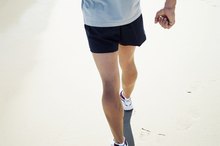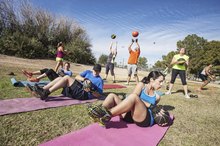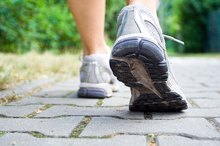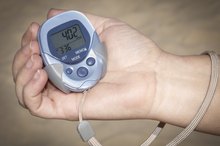What does fact checked mean?
At Healthfully, we strive to deliver objective content that is accurate and up-to-date. Our team periodically reviews articles in order to ensure content quality. The sources cited below consist of evidence from peer-reviewed journals, prominent medical organizations, academic associations, and government data.
- Journal of Physical Activity and Health: A Comparison of Fitness Training to a Pedometer-based Walking Program Matched for Total Energy Cost
- Journal of Physical Activity and Health: A Comparison of Fitness Training to a Pedometer-based Walking Program Matched for Total Energy Cost
- Harvard Medical School: Counting Every Step You Take
- Centers for Disease Control and Prevention: General Physical Activitys Defined by Intensity
- American Council on Exercise; How to Lose Fat, Gain Muscle, Feel Happier and Get Healthier – At No Cost?
The information contained on this site is for informational purposes only, and should not be used as a substitute for the advice of a professional health care provider. Please check with the appropriate physician regarding health questions and concerns. Although we strive to deliver accurate and up-to-date information, no guarantee to that effect is made.
Can You Lose Weight Just by Walking 10,000 Steps a Day?
If you're walking to lose weight, there may be no "magic" number of minutes, strides or miles you must complete to burn excess fat. Some studies show that you can lose weight and increase your level of physical fitness by simply walking 10,000 steps a day. However, your results also depend on the amount of energy behind your pace.
Benefits of Walking
A comfortable pair of walking shoes and a stretch of open terrain may be all you need to get in physical shape -- and to lose or maintain weight. The American Council on Exercise states that this no-cost fitness program yields other health advantages as well, such as lowering your blood pressure, reducing your risk of diabetes and keeping your blood cholesterol levels in check. Depending on the length of your stride, 10,000 steps will carry you about 5 miles.
Study
How to Lose 20 Pounds in Two Months by Walking
Learn More
The University of Alberta published results of a walking study in the March 2010 issue of "Journal of Physical Activity and Health." A total of 128 inactive adults were randomly assigned to various groups. One group engaged in a fitness program four days a week; another group was given pedometers and assigned a walking program that involved taking 10,000 steps each day; and the last maintained their existing level of physical activity. After six months, researchers found that body mass index and waist circumference was reduced in all groups; however, only the fitness group noticed a change in rate of perceived exertion, or RPE. Researchers concluded that supervised training sessions yielded the best results when it came to reducing RPE and blood pressure; however, they further noted that "not other fitness and health-related variables compared with a pedometer-based walking program matched for total energy cost. 1"
- The University of Alberta published results of a walking study in the March 2010 issue of "Journal of Physical Activity and Health."
- Researchers concluded that supervised training sessions yielded the best results when it came to reducing RPE and blood pressure; however, they further noted that "not other fitness and health-related variables compared with a pedometer-based walking program matched for total energy cost.
Walking Intensity
If you want to lose weight, the amount of energy you put into physical activity matters. According to Harvard Medical School, research shows that some people who walk 10,000 steps each day don't exert themselves enough for the activity to meet "moderate" criteria, while others who don't make this goal exercise at just the right intensity -- according to the Centers for Disease Control and Prevention, walking on a level surface between 3 mph and 4.5 mph is considered a moderately exhaustive physical activity 35. Harvard states that walking energetically for 30 minutes is better for your cardiovascular system -- and better for weight control -- than taking 10,000 steps at an easy amble.
Other Information
Is Walking 15 Minutes a Day Enough for Weight Loss?
Learn More
The U.S. Surgeon General and American College of Sports Medicine recommended that healthy adults put in a half hour of moderate-to-intense aerobic activity at least five days a week, but preferably as many days as you can. And, according to ACE, walking 10,000 brisk steps a day is consistent with these guidelines. However, Harvard Medical School reports that 30 minutes of moderate exercise each day might not be enough if you want to lose weight, citing data from the Institute of Medicine which suggests that an hour of exercise is better at burning up surplus calories 2. In addition, regardless of how many steps you take per day, you won't lose weight if your calorie intake still exceeds expenditure; so eat a healthy diet and watch your portion size.
- The U.S.
- Surgeon General and American College of Sports Medicine recommended that healthy adults put in a half hour of moderate-to-intense aerobic activity at least five days a week, but preferably as many days as you can.
- However, Harvard Medical School reports that 30 minutes of moderate exercise each day might not be enough if you want to lose weight, citing data from the Institute of Medicine which suggests that an hour of exercise is better at burning up surplus calories 2.
Related Articles
References
- Journal of Physical Activity and Health: A Comparison of Fitness Training to a Pedometer-based Walking Program Matched for Total Energy Cost
- Harvard Medical School: Counting Every Step You Take
- Centers for Disease Control and Prevention: General Physical Activitys Defined by Intensity
- American Council on Exercise; How to Lose Fat, Gain Muscle, Feel Happier and Get Healthier – At No Cost?
- Centers for Disease Control: How Much Physical Activity Do Adults Need?
- More People Walk to Better Health. Centers for Disease Control and Prevention. August 6, 2013
- Walking Take the First Step. American Heart Association. Updated May 2020
- Murtagh EM, Murphy MH, Boone-Heinonen J. Walking: the first steps in cardiovascular disease prevention. Curr Opin Cardiol. 2010;25(5):490-496. doi:10.1097/HCO.0b013e32833ce972
- Regular Walking May Protect Against Heart Failure Post Menopause. American College of Cardiology. March 01, 2018
- Omura JD, Ussery EN, Loustalot F, Fulton JE, Carlson SA. Walking as an opportunity for cardiovascular disease prevention. Prev Chronic Dis. 2019;16:E66. Published 2019 May 30. doi:10.5888/pcd16.180690
- Garber CE, Blissmer B, Deschenes MR, et al. American College of Sports Medicine position stand. Quantity and quality of exercise for developing and maintaining cardiorespiratory, musculoskeletal, and neuromotor fitness in apparently healthy adults: guidance for prescribing exercise. Med Sci Sports Exerc. 2011;43(7):1334-59. doi:10.1249/MSS.0b013e318213fefb
- Exercise for Your Bone Health. National Institutes of Health Osteoporosis and Related Bone Diseases. Reviewed October 2018
- Benedetti MG, Furlini G, Zati A, Letizia Mauro G. The effectiveness of physical exercise on bone density in osteoporotic patients. Biomed Res Int. 2018;2018:4840531. Published 2018 Dec 23. doi:10.1155/2018/4840531
- 12 Benefits of Walking. Arthritis Foundation
- Know Your Risk for Heart Disease. Centers for Disease Control and Prevention. Updated December 9, 2019
- Soroush A, Der Ananian C, Ainsworth BE, et al. Effects of a 6-month walking study on blood pressure and cardiorespiratory fitness in U.S. and swedish adults: ASUKI step study. Asian J Sports Med. 2013;4(2):114-124. doi:10.5812/asjsm.34492
- Mandini S, Conconi F, Mori E, Myers J, Grazzi G, Mazzoni G. Walking and hypertension: greater reductions in subjects with higher baseline systolic blood pressure following six months of guided walking. PeerJ. 2018;6:e5471. Published 2018 Aug 30. doi:10.7717/peerj.5471
- Colberg SR, Sigal RJ, Fernhall B, et al. Exercise and type 2 diabetes: the American College of Sports Medicine and the American Diabetes Association: joint position statement. Diabetes Care. 2010;33(12):e147-e167. doi:10.2337/dc10-9990
- Hamasaki H. Daily physical activity and type 2 diabetes: A review. World J Diabetes. 2016;7(12):243-251. doi:10.4239/wjd.v7.i12.243
- Kleist B, Wahrburg U, Stehle P, et al. Moderate walking enhances the effects of an energy-restricted diet on fat mass loss and serum insulin in overweight and obese adults in a 12-week randomized controlled trial. J Nutr. 2017;147(10):1875-1884. doi:10.3945/jn.117.251744
- Baker EH, Milner AN, Campbell AD. A pilot study to promote walking among obese and overweight individuals: walking buses for adults. Public Health. 2015;129(6):822-824. doi:10.1016/j.puhe.2015.03.021
- Wang Y, Xu D. Effects of aerobic exercise on lipids and lipoproteins. Lipids Health Dis. 2017;16(1):132. Published 2017 Jul 5. doi:10.1186/s12944-017-0515-5
- Ruiz-Ramie JJ, Barber JL, Sarzynski MA. Effects of exercise on HDL functionality. Curr Opin Lipidol. 2019;30(1):16-23. doi:10.1097/MOL.0000000000000568
- Zhao W, Ukawa S, Kawamura T, et al. Health benefits of daily walking on mortality among younger-elderly men with or without major critical diseases in the new integrated suburban seniority investigation project: a prospective cohort study. J Epidemiol. 2015;25(10):609-616. doi:10.2188/jea.JE20140190
- Reimers CD, Knapp G, Reimers AK. Does physical activity increase life expectancy? A review of the literature. J Aging Res. 2012;2012:243958. doi:10.1155/2012/243958
- The Emotional Benefits of Exercise. NIH National Institute on Aging.
- Bailey DP, Locke CD. Breaking up prolonged sitting with light-intensity walking improves postprandial glycemia, but breaking up sitting with standing does not. J Sci Med Sport. 2015;18(3):294-8. doi:10.1016/j.jsams.2014.03.008
- Williams PT. Greater weight loss from running than walking during a 6.2-yr prospective follow-up. Med Sci Sports Exerc. 2013;45(4):706-713. doi:10.1249/MSS.0b013e31827b0d0a
- Williams PT, Thompson PD. Walking versus running for hypertension, cholesterol, and diabetes mellitus risk reduction. Arterioscler Thromb Vasc Biol. 2013;33(5):1085-91. doi:10.1161/ATVBAHA.112.300878
- Donnelly JE, Blair SN, Jakicic JM, et al. American College of Sports Medicine Position Stand. Appropriate physical activity intervention strategies for weight loss and prevention of weight regain for adults. Med Sci Sports Exerc. 2009;41(2):459-71. doi:10.1249/MSS.0b013e3181949333
- Tudor-Locke, C., Aguiar, E.J., Han, H. et al. Walking cadence (steps/min) and intensity in 21–40 year olds: CADENCE-adults. Int J Behav Nutr Phys Act 16, 8 (2019). doi:10.1186/s12966-019-0769-6
- Physical Activity Guidelines for Americans 2nd Edition. U.S. Department of Health and Human Services. 2018
Resources
Writer Bio
Lisa Sefcik has been writing professionally since 1987. Her subject matter includes pet care, travel, consumer reviews, classical music and entertainment. She's worked as a policy analyst, news reporter and freelance writer/columnist for Cox Publications and numerous national print publications. Sefcik holds a paralegal certification as well as degrees in journalism and piano performance from the University of Texas at Austin.









